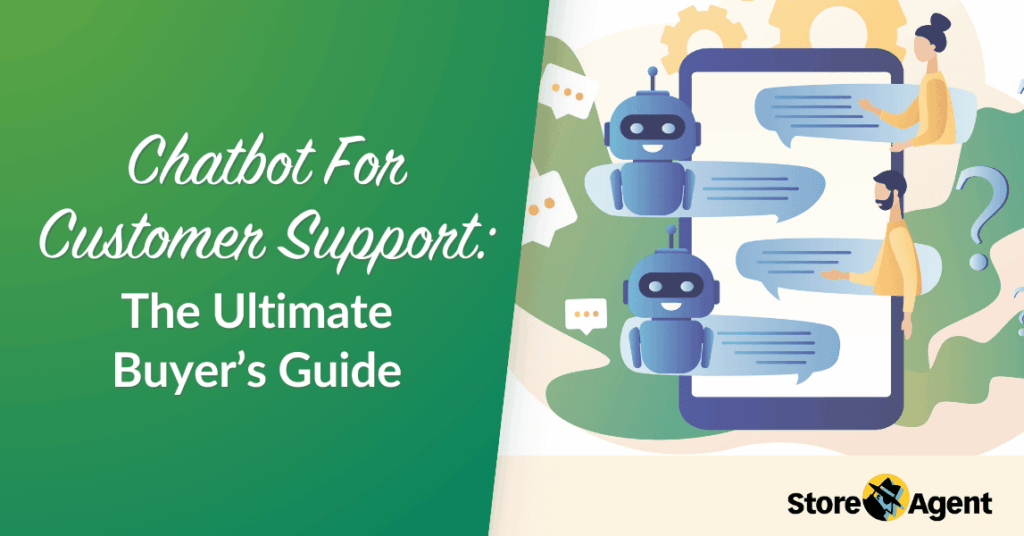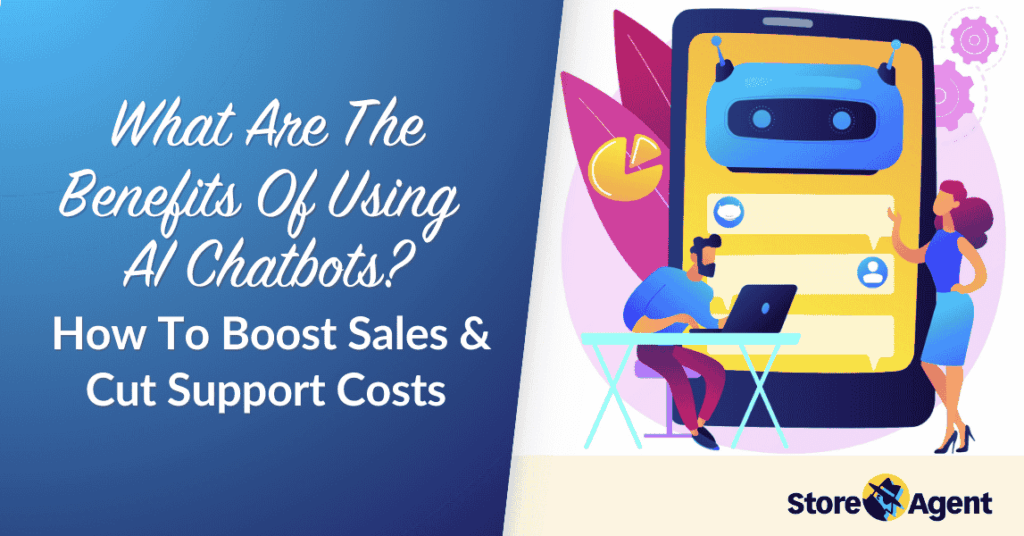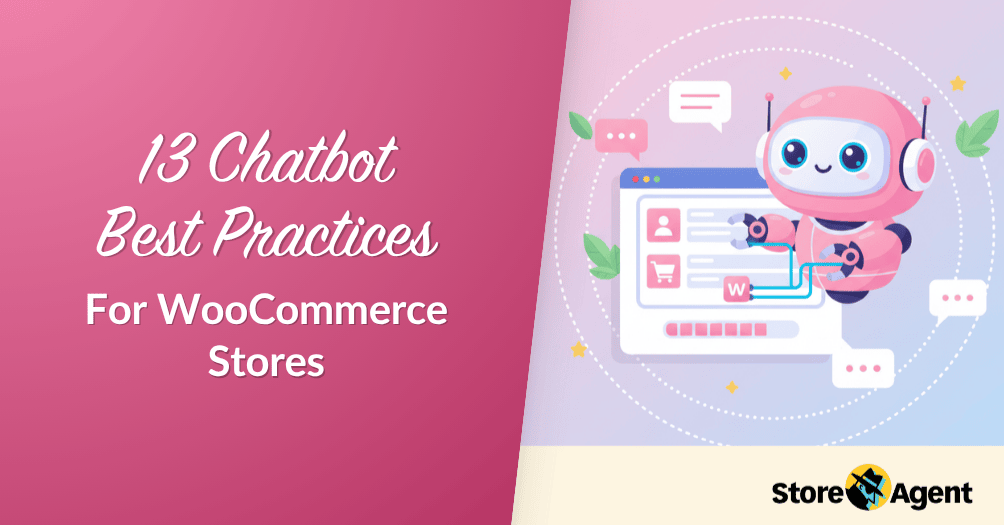
Most chatbots fail within the first month of launch. Research shows that 50% of customers abandon a conversation with a bot that can’t understand their question. This happens because store owners skip basic chatbot best practices during setup and training.
Your WooCommerce store needs a chatbot that actually helps customers instead of frustrating them. A poorly configured bot drives shoppers away. Meanwhile, stores that follow proven chatbot best practices see higher customer satisfaction and better sales.
In this guide, you’ll learn 13 proven chatbot best practices for WooCommerce stores. These tips cover everything from setup to ongoing optimization. By the end, you’ll know how to build a chatbot that improves customer experience and boosts conversions.
Table Of Contents
- What Is A Chatbot?
- How To Plan Your Chatbot Implementation
- Best Chatbot Configuration Practices
- How To Train And Optimize Your Chatbot
- Best Practices For Continuous Chatbot Improvement
- Common Chatbot Mistakes To Avoid
- Implement Best Practices With StoreAgent Chat
- Start Implementing Chatbot Best Practices Today
- Frequently Asked Questions
What Is A Chatbot?
A chatbot is software that talks with customers through text messages on your website. Modern chatbots use artificial intelligence to understand questions and respond naturally. For WooCommerce stores, this means automated help for shoppers 24/7.
Think of a chatbot as your always-on store assistant. It answers product questions, checks order status, and helps customers find what they need. Unlike humans, it never sleeps or takes breaks.
Why does following chatbot best practices matter?
Most store owners install a chatbot and expect it to work perfectly immediately. However, without proper setup and training, chatbots give wrong answers or frustrate customers.
Following proven best practices prevents these problems and ensures your chatbot actually helps instead of hurting sales.
How To Plan Your Chatbot Implementation
Before you install anything, proper planning prevents most chatbot failures. These three practices help you start with a clear strategy.

1. Define clear goals before setup
Most store owners install a chatbot without knowing what they want it to do. This leads to confusion and poor results later on. Instead, start by writing down specific goals your chatbot should achieve.
For example, you might want to reduce support tickets by 30% in three months. Or maybe you want to capture 50 new leads per week. Having clear goals helps you measure success and spot problems early.
Track metrics like response time, resolution rate, and customer satisfaction scores. These numbers tell you if your chatbot actually works.
2. Map your customer’s common questions
Before you configure anything, look at your existing support tickets. What do customers ask most often? Write down the top 10-15 questions you see repeated weekly.
Common WooCommerce questions usually include shipping times, return policies, and product specifications. Your chatbot should answer these perfectly before launch. Group similar questions together by topic like orders, products, or account issues.
3. Choose the right chatbot for your store
Not all chatbots work the same way. Small stores with 50 products need different features than large stores with 5,000 items. Think about your store size and customer volume before picking a solution.
For WooCommerce specifically, you need a chatbot that syncs with your product catalog automatically. It should pull real information about stock, prices, and variations. Generic chatbots can’t do this without manual setup.
Additionally, consider your budget for ongoing costs. Some chatbots charge per conversation or API call. Others offer flat monthly rates. Pick one that fits your expected message volume.
For a deeper dive into the best WordPress chatbot plugins, check out our detailed guide:
Best WordPress Chatbot Plugin For Online Stores In 2025
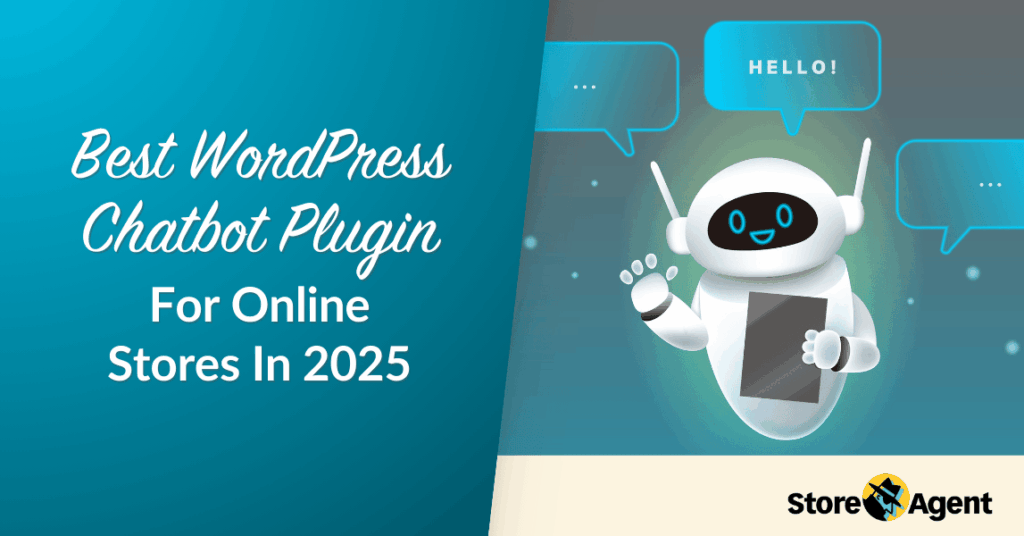
Best Chatbot Configuration Practices
The way you configure your chatbot determines whether customers will actually use it. These four practices ensure your setup drives engagement.

4. Position your widget strategically
Where you place your chatbot widget makes a huge difference in engagement. Most stores put it in the bottom right corner on desktop. However, mobile placement needs more thought because screen space is limited.
Test both open and closed default states to see what works better. An open chatbot grabs attention immediately. A closed one stays out of the way until needed. StoreAgent Chat lets you set different positions for desktop and mobile automatically.
Moreover, consider timing your widget appearance. Pop up after 10 seconds on product pages. Wait 30 seconds on the homepage. This prevents annoying visitors who just arrived.
5. Set clear expectations in welcome message
Your welcome message is the first thing customers see. It needs to explain what the chatbot can and can’t do clearly. Don’t pretend to be human if you’re obviously a bot.
A good welcome message sounds like this: “Hi! I’m here to help with product info, orders, and shipping questions. I’m available 24/7. What can I help you find?” This sets realistic expectations right away.
Avoid vague greetings like “How can I help you today?” Instead, list 2-3 specific things you handle well. For example, “I can check order status, recommend products, or answer shipping questions.” This guides users toward successful chatbot interactions.
6. Integrate with your store data
Your chatbot needs access to real WooCommerce data to give accurate answers. Connect it to your product catalog, order history, and inventory system. Otherwise, it will provide outdated or wrong information.
When a customer asks about a specific product, your chatbot should pull current pricing and stock levels. If someone checks their order status, it should fetch real tracking information. This level of integration requires a WooCommerce-aware chatbot like StoreAgent.
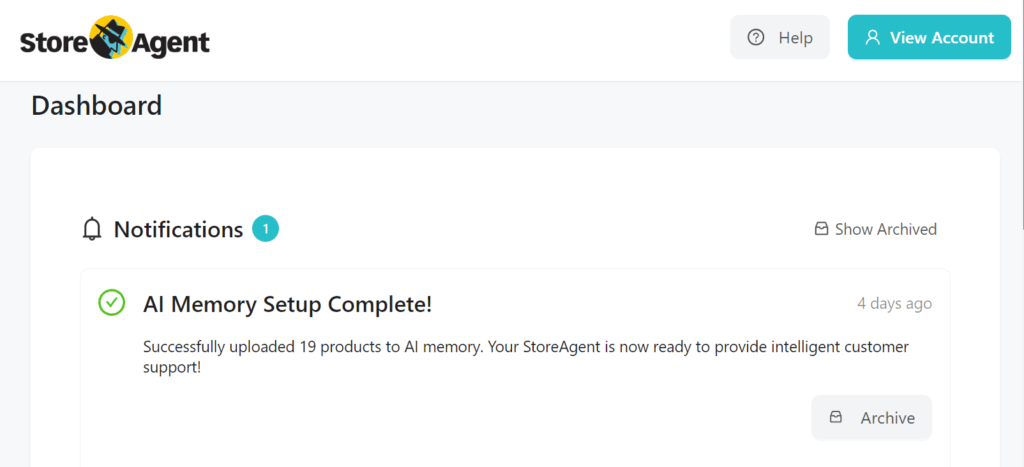
Furthermore, sync your chatbot with customer accounts when possible. This allows personalized responses based on purchase history. It makes recommendations more relevant and useful.
7. Design smart escalation protocols
No chatbot can handle everything perfectly. You need clear rules for when to hand off to a human agent. This prevents frustrated customers from getting stuck in bot loops.
Set up escalation triggers for complex issues like refunds, damaged items, or technical problems. When the chatbot detects these keywords, it should immediately offer human support. Make the transition smooth by passing conversation history to your team.
Additionally, always give customers a way to reach a human. Include a “Talk to a person” button in your chatbot menu. Some people just prefer human help regardless of the question.
How To Train And Optimize Your Chatbot
A chatbot is only as good as its training data and ongoing improvements. These four practices help you refine responses and catch issues quickly.
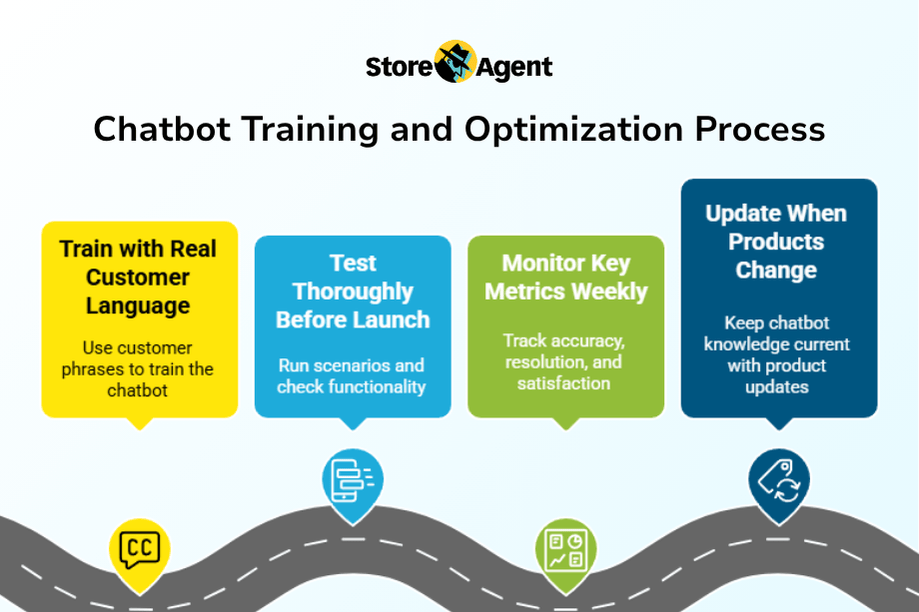
8. Train with real customer language
Your chatbot should sound like your customers, not a corporate manual. Use the exact phrases people type in support tickets and chat logs. Avoid technical jargon unless your audience uses it regularly.
For instance, if customers say “Where’s my stuff?” instead of “Track my order,” train your bot to recognize both. The more natural the conversation feels, the better customer experience you create.
Test responses by having team members chat with the bot like customers would. Look for awkward or confusing replies. Fix them before going live with real shoppers.
9. Test thoroughly before launch
Run through every common scenario on both desktop and mobile devices. Check that buttons work correctly and links go to the right pages. Test edge cases like typing gibberish or asking impossible questions.
Create a QA checklist that includes product lookups, order tracking, and policy questions. Make sure your chatbot handles misspellings and different phrasings of the same question. This prevents embarrassing errors after launch.
Moreover, test during peak traffic times if possible. Some chatbots slow down under heavy load. You want to catch performance issues before customers experience them.
10. Monitor key metrics weekly
Track response accuracy, resolution rate, and customer satisfaction scores every week. These metrics show whether your chatbot actually helps people. Most WordPress dashboards include basic analytics for this.
Pay special attention to conversations that get escalated to humans. If the same question causes escalations repeatedly, your chatbot needs better training on that topic. Also watch for drop-off points where users abandon the conversation.
11. Update when products change
Your chatbot’s knowledge gets stale fast if you don’t keep it updated. When you add new products, the bot needs to know about them immediately. Same for price changes or discontinued items.
StoreAgent Chat syncs automatically with your WooCommerce catalog, so you don’t have to update manually. Other chatbots might require you to retrain or refresh data weekly. This becomes tedious with large product catalogs.
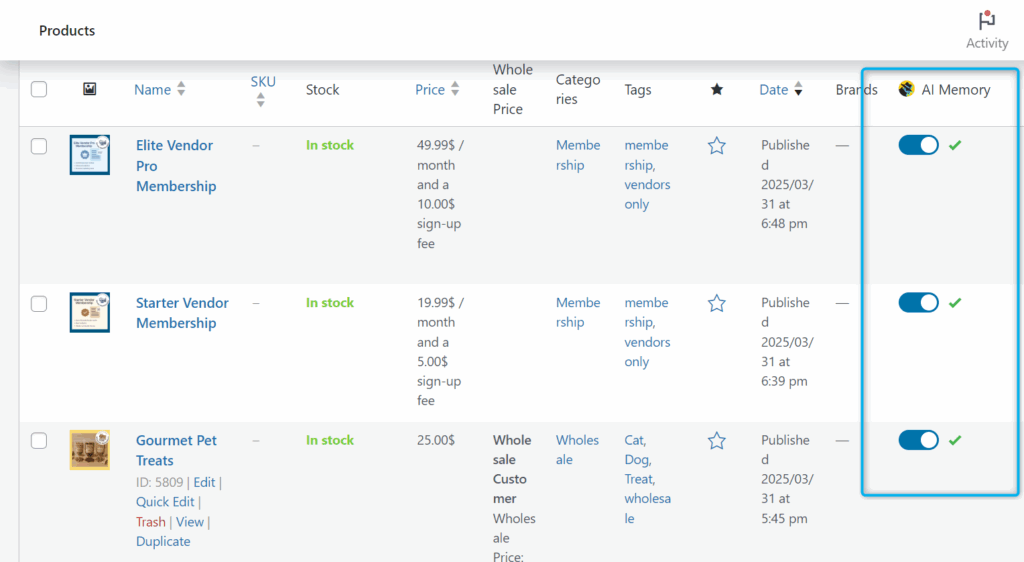
Additionally, update policy information when it changes. If you modify your return window from 30 to 45 days, make sure the chatbot reflects this. Outdated info creates customer service problems.
Best Practices For Continuous Chatbot Improvement
Even the best chatbot needs regular attention to stay useful. These final two practices help you identify opportunities and maintain quality over time.

12. Collect feedback systematically
Ask customers to rate the chatbot conversation after it ends. Use a simple thumbs up/down or 1-5 star rating. This shows you which interactions work well and which need fixing.
When someone leaves negative feedback, review that conversation manually. Look for patterns in failed interactions. Maybe your bot struggles with a specific product category or question type.
Furthermore, act on feedback quickly. If multiple people complain about the same issue within a week, prioritize fixing it. Customers notice when you respond to their input.
13. Analyze conversation logs monthly
Set aside time each month to review chat logs in detail. Look for questions your bot couldn’t answer or conversations that went in circles. These reveal gaps in your training data.
Conversation logs also show unexpected ways customers phrase their questions. Add these variations to your training to improve accuracy. You’ll discover new product information customers want that isn’t currently available.
Moreover, spot opportunities for upselling and cross-selling. If many customers ask about accessories for a product, your chatbot could proactively suggest them. This turns customer service into a revenue channel.
Common Chatbot Mistakes To Avoid
Many stores make the same errors when deploying chatbots. Avoid these pitfalls to keep customer experience positive:
- Using overly formal or robotic language that feels fake
- Covering too many topics at once instead of focusing on core questions
- Not providing a clear way to reach human support when needed
- Ignoring mobile users with poorly optimized chat windows
- Failing to test on different browsers and devices before launch
These mistakes frustrate customers and damage trust in your brand. Take time to avoid them during setup and testing.
Implement Best Practices With StoreAgent Chat
According to IBM, AI chatbots using machine learning can understand user goals and provide more detailed, accurate responses compared to rule-based chatbots. The key difference is that AI-powered chatbots continuously learn from interactions, while traditional chatbots remain limited to predefined scripts.
StoreAgent Chat is a WooCommerce AI chatbot plugin built specifically with these chatbot best practices in mind. Based on deployments across 1,000+ stores worldwide, it addresses the common setup challenges that traditional rule-based chatbots can’t handle.
Key StoreAgent features that follow best chatbot practices:
- Syncs with your product catalog and order data in real time for accurate answers
- Eliminates manual updates about stock levels, pricing, and order status
- Integrates with WordPress dashboard for tracking customer service metrics
- Includes smart chat widget positioning for desktop and mobile
- Offers many customization options including welcome messages
- Supports a multilingual AI chatbot experience natively
- Handles WooCommerce-specific questions about products and shipping natively
Unlike generic chatbots that require extensive training, this AI-powered solution understands e-commerce context from day one. This reduces setup time from weeks to minutes while maintaining the chatbot best practices and customer experience standards.
Related reads
Want to learn more about chatbots for your WooCommerce store? Check out these guides:
Start Implementing Chatbot Best Practices Today
Effective chatbot use isn’t about ticking boxes but about creating a smooth and helpful experience for your customers. It starts with clear goals and understanding what your customers really ask.
Choosing a WooCommerce-friendly chatbot that keeps product and order info up to date can save hours of manual work.
Here are the 13 chatbot best practices to follow:
- Defining clear goals before setup
- Mapping your customer’s common questions
- Choosing the right chatbot for your store
- Positioning your widget strategically
- Setting clear expectations in the welcome message
- Integrating with your store data
- Designing smart escalation protocols
- Training with real customer language
- Testing thoroughly before launch
- Monitoring key metrics weekly
- Updating when products change
- Collecting feedback systematically
- Analyzing conversation logs monthly
Ready to implement these chatbot best practices? Explore StoreAgent Chat and see how it makes setup easier for WooCommerce stores.
Frequently Asked Questions
What are the most important chatbot best practices?
The top three chatbot best practices are defining clear goals before setup, integrating with your store data, and testing thoroughly before launch. These fundamentals prevent most common problems. Additionally, monitoring metrics weekly helps you improve over time.
Should my chatbot be open or closed by default?
This depends on your store and traffic patterns. Open chatbots get more engagement but can distract some visitors. Closed chatbots stay out of the way until needed. Test both options for two weeks each and compare engagement rates to decide.
How often should I update my chatbot?
Update your chatbot whenever you add products, change prices, or modify policies. Additionally, review conversation logs monthly to spot training gaps. Weekly metric checks help you catch problems quickly. Most WooCommerce chatbots like StoreAgent sync automatically, reducing manual work.



